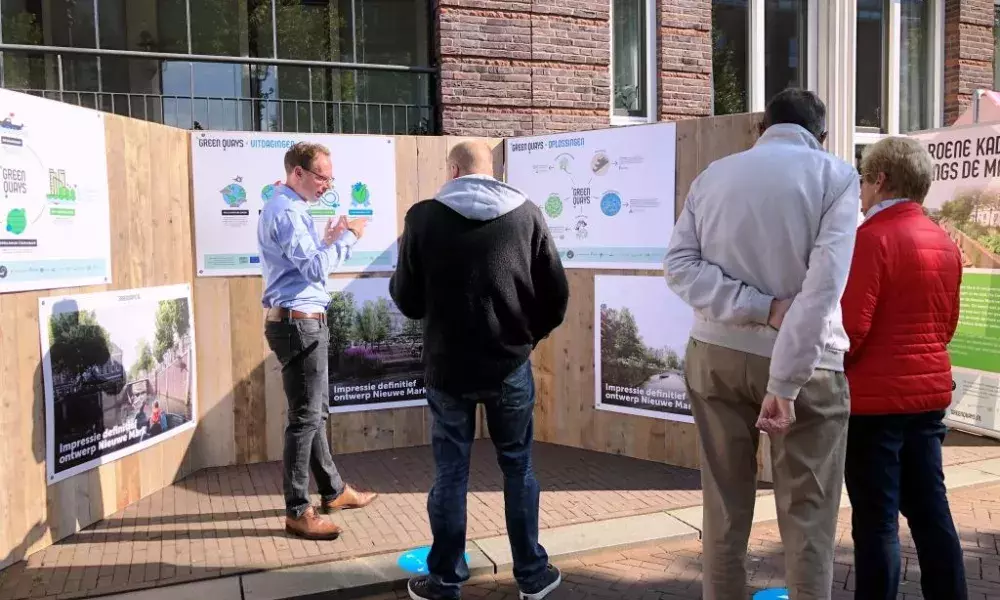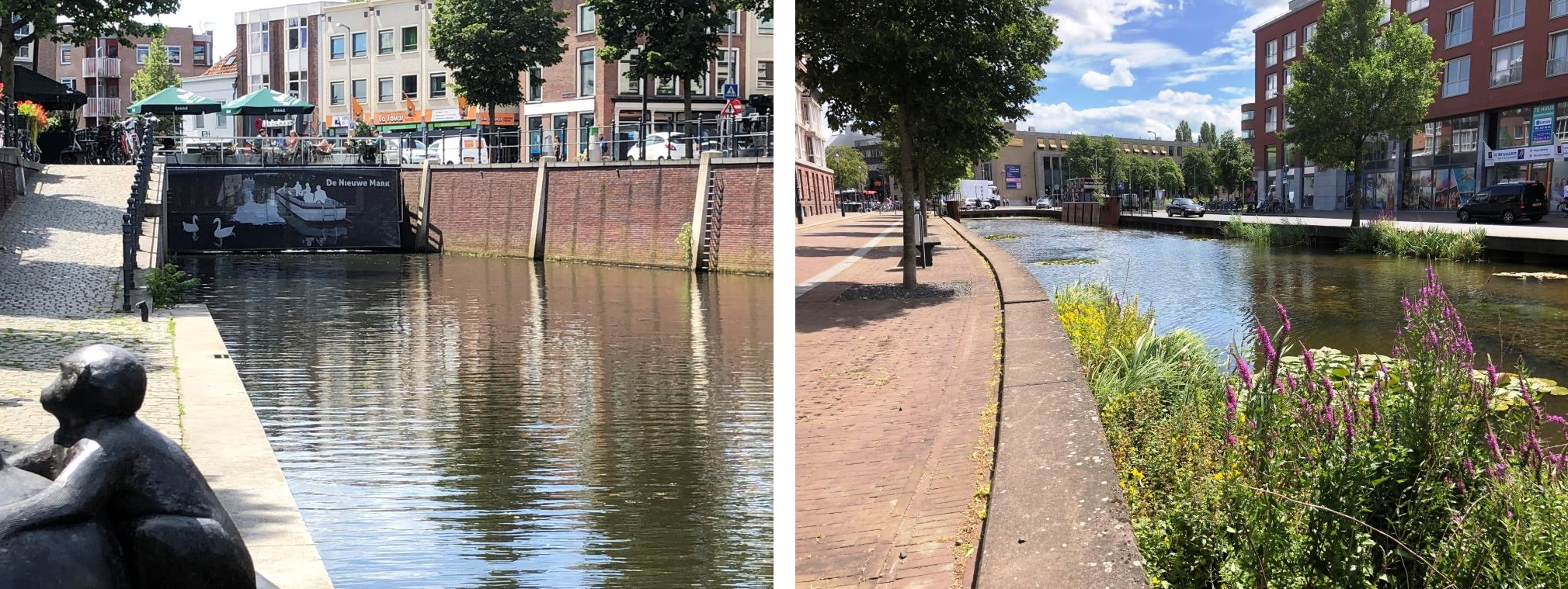
Going new ways and going green is not completely uncommon to Breda municipality. The bigger project De Nieuwe Mark (the new river Mark), of which GreenQuays is a part of, started in the early 2000s. In 2007, a part of an old channel has already been reopened although not to full depth. In the meantime, nature was allowed to invade quay walls and simple temporary support structures, like wooden platforms and gabions, have been tested to boost nature in the quays and around. Along the 2 km of the New Mark, the alderman and the city council strongly supported to go for greener quays and forwarded the GreenQuays project. Curious about Breda’s approach for creating an innovative partnership, I asked Roel Klei, project leader, and Veerle Hemerik, project manager of GreenQuays at the municipality how the project partners were found that fit so well together. Actually, they couldn’t exactly tell me. Probably, the selection was based to a huge part of intuition because of already long-term collaborations and the existing innovative climate. Some partners have already worked well together before; others came in on specific tasks and, eventually, recommended further ones. Partners needed to be found for specific questions bringing new facets into the team, like: Who can grow bended trees in walls? Who can conduct research on stable quay wall construction that, at the same time, supports nature? What can be an appropriate substrate to grow in? How can the effectivity of green infrastructure be maximised for climate-resilience in a dense urban setting?
Curious about Breda’s approach for creating an innovative partnership, I asked Roel Klei, project leader, and Veerle Hemerik, project manager of GreenQuays at the municipality how the project partners were found that fit so well together. Actually, they couldn’t exactly tell me. Probably, the selection was based to a huge part of intuition because of already long-term collaborations and the existing innovative climate. Some partners have already worked well together before; others came in on specific tasks and, eventually, recommended further ones. Partners needed to be found for specific questions bringing new facets into the team, like: Who can grow bended trees in walls? Who can conduct research on stable quay wall construction that, at the same time, supports nature? What can be an appropriate substrate to grow in? How can the effectivity of green infrastructure be maximised for climate-resilience in a dense urban setting?
All the partners I met seem to be open minded and have told me that exactly the many different pieces of expertise in the team makes it so exciting for them to work with each other. The partners are happy to share their knowledge and learn from each other. For example:
Koen Mulder from the Technical University Delft has researched on bricks, mortar and construction pattern for stable quay walls before the project’s design team challenged him to integrate nature. In return, the design team has learned about the different qualities of brick and mortar combinations. Again, the partners Natuurplein and RAVON, both nature conservation NGOs, bring forward all the ecological requirements for boosting nature. They find solutions in joint discussions, while each partner broadens its knowledge.
The team from TU Delft has also learned from the colleagues of Van de Berk, a nursery that is responsible for establishing the bended trees in the walls, on sensor technology to monitor the different environmental parameters, like wetness, temperature, etc. They use that knowledge on monitoring the vegetated walls of the small-sale test site now.
Jan van Kemp and Jeroen den Brok from the nursery, knowing that trees support to tackle climate impacts such as heatwaves, ask the colleagues from Wageningen University, where these trees can be placed best to maximise their support to climate resilience.
Vaporisation in public space for cooling has not been on the radar of Breda municipality, but João Cortesão, a researcher at Wageningen University but originally from Portugal, has brought up this idea, which is now integrated into the final design of the area.
The different partners are curious about the knowledge of the others. That is a big motivating factor to collaborate.” Willem de Brouwer, leading the design team in Breda municipality
The explicit focus on innovative over business as usual solutions in the GreenQuays project and its 80% funding by the EU have created an important space for experiments. The partnership could also become broader; more partners and with interesting niche competences enrich the whole team. Willem de Brouwer, who is in lead of the design team, said that they would probably have not thought about things such as setting trees into the middle of stairs without this project. The same holds for a completely new artificial lighting strategy, where many different aspects are to be integrated, like energy saving and smart lightning, safety, aesthetics, and ecological considerations, such as implications for vegetation, animal life and light pollution.
Despite the need to deliver solutions at the end of the project, this space for experiments and innovation includes the acceptance of failures as a mean to learn and develop new or better solutions. Furthermore, the project is not only about developing innovative ideas but implementing them in real life, which happens rarely for researchers and other partners. Whether it is to see your ideas come to life or, as a researcher, the opportunity to monitor the conditions before and after real implementation to prove your models. These by-products turn out to be big motivating factors for the partners, who have been eager to join the project.
Some things may not work out as supposed, but we cannot fail, because there will always be a solution. If not this one, we find another one together. Veerle Hemerik, project manager of GreenQuays
The innovative climate explains, however, not yet fully the smooth collaboration in the partnership. Since the beginning, Breda municipality as the lead partner has involved the different partners actively in putting the project together. During that process the goals, specific tasks, roles, potential conflicts, and appropriate budget was negotiated with each partner. It created trust and a common understanding. This clarity pays off now. The single partners know what to do, feel ownership for their piece of work as part of the whole project and take responsibility.
Definitely, there is the willingness of all partners to find solutions for tricky challenges and make the project a success. For example, the maintenance team of the current and future quays was known as usually strict, but in this project, they have become excited about the new solutions. This was due to their early and ongoing involvement in the projects. Once maintenance staff felt that their concerns were taken seriously, started to see the bigger pictures and understood the added value, they have supported it strongly.
For the partners, this outstanding project is a great business opportunity. In that collaboration, they can further professionalise and gain new expertise and extend their profile. The implemented solutions as a showcase provide them visibility far beyond the project. This is interesting for all partners, but in particular interesting for the smaller ones like BLAST, which can now be part of something big. Karin Moll from the partner Brabantse Delta Waterboard, which is the responsible regional body for water management, sees GreenQuays as a perfect testbed for solutions to scale up in the whole region.
All the mentioned factors and circumstances keep the motivation of each single partner high, and they engage actively and collaborate in this partnership for the benefit of boosting ideas and the creative potential. Veerle Hemerik and Roel Klei, who are in the project lead, will keep an eye on maintaining that motivation level by creating and sustaining the necessary working conditions.
About this resource
The Urban Innovative Actions (UIA) is a European Union initiative that provided funding to urban areas across Europe to test new and unproven solutions to urban challenges. The initiative had a total ERDF budget of €372 million for 2014-2020.
Similar content




